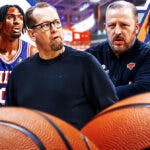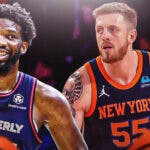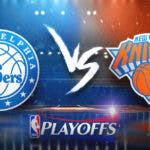It's been a brutal three-month-long stretch for New York Knicks fans. Well, more like two-decade-long stretch, but recently the end of the 2018-19 NBA season saw the Knicks miss the playoffs for the sixth consecutive year—and possess the league's worst record—drop two spots in the new-odds draft lottery in May, and miss out on some high-end free agents in Kevin Durant and Kyrie Irving.
The biggest names coming out of New York's offseason will be two lefties in 24-year-old power forward Julius Randle and incoming freshman R.J. Barrett—the third overall pick in the 2019 NBA Draft by the Knicks.
Barrett was a stud in his one-and-done season at Duke University, playing alongside pal Zion Williamson, but in his brief, two-game Las Vegas Summer League debut, Barrett's done nearly nothing but miss bad shot after bad shot.
The Summer League, however, is not the best indication for the unwritten future of Barrett's, or anybody's really, NBA career.
Through two games, Barrett, 19, has scored 18 total points on 33 field goal attempts. He's coughed up the rock 10 times—eight in the matchup with the Phoenix Suns—hasn't made great shot selections, and generally looks a bit lost on defense against competition that should mostly be below someone of his status (number one prospect going into the NCAA season this time last year, best young Canadian player, leading scorer in the ACC with Williamson).
Possibly the most concerning part of Barrett's (lack of) game in Summer League so far has been his inability to break down defenders and get to the bucket with confidence—a part of R.J.'s game that will be quintessential to what could make him great in the Association.
This is all to say that none of this actually matters. Two Summer League games don't make or break a top-three player's NBA career, and they certainly don't illustrate whether a prospect is a bust or not.

First, let's start with Barrett himself. Here are some good observations in R.J.'s first 57 minutes of (semi-)professional hoops.
Barrett has been to the free throw line eight times. He's struggled to hit an unimpeded from the charity stripe—shooting 2-for-8—but the idea that the 6-foot-7 swingman is either standing around doing nothing or hoisting up poor shots is not exactly accurate.
And on his shooting struggles, it's been well documented that Barrett tweaked his mechanics since the last time we saw him compete in the NCAA tournament with the Blue Devils. Barrett worked with Chris Hanlen, infamous for attempting to smooth out former first-overall pick Markelle Fultz's shot in spite of Fultz dealing with thoracic outlet syndrome, and one of the primary issues was moving Barrett's right hand, he's a southpaw after all, to the side of them instead of on top of it. This will allow R.J. to release his shot quicker.
Barrett has not been able to properly demonstrate his new mechanics in a competitive atmosphere…ever. Summer League is Steve Nash's godson's first opportunity to get his new-found shot up, and it would explain why he's struggled shooting (7-of-33 from the floor) even from the free throw line.
Here you'll see Knicks assistant coach Jud Buechler talk about why he's not concerned about Barrett's “struggles,” plus a look at the beginning of R.J.'s reformed shooting motion:
"RJ has done some great things." @nyknicks assistant coach on Barrett's play in first two @NBASummerLeague games. pic.twitter.com/GCysXL4sOQ
— MSG Networks (@MSGNetworks) July 8, 2019
Second, on the positive side, Vegas hasn't been a total loss for Barrett and working on his game. R.J. is a talented rebounder for his position, and he also possesses an above-average vision for his position at the wing. He's essentially played positions one through three on the floor so far, and he's pulled down 15 rebounds in two games. The official assists tally has been slow, but besides plenty of missed open teammates, particularly in Barrett's debut game, the SummerKnicks have shot 40% from the field in two matches.
These are the type of passes you can expect from RJ Barrett pic.twitter.com/keaYOIcJd6
— Reid Goldsmith (@reidgoldsmith) July 8, 2019
There have been enough looks and passes Barrett has made that simply haven't been converted into made field goals by his teammates. It's not the end of the world.
Third, for comparison sake, there is a luxury of examples of future stars and high draft picks not living up to Summer League billing.
Kevin Durant, who scorned the Knicks this offseason for the Brooklyn Nets, played in two summer games across two years—averaging 25.5 points…on 45.2% from the floor, including a real stinker of a 33% field goal percentage game in 2007.
Another Rookie of the Year, then–Chicago Bulls point guard Derrick Rose appeared in two Summer League games before his freshman year, scoring 19 total points on a ghastly 29.4% from the floor. Rose's shot looked terrible 11 years ago, but concerns were quickly thrown away when he had an extended look in the form of an 82-game regular season for the Bulls.
Lastly, and most recently, Atlanta Hawks point guard Trae Young was the butt of many jokes this time last year—the Rookie of the Year runner-up shot 30.3% from the field, scoring 15.1 points per game in seven appearances. Now, folks around the league speak highly of Young's long-range shooting, surprisingly great at-the-rim efficiency, and outstanding playmaking ability.
Truly, it's not time to panic about R.J. Barrett, who Knicks fans are now pinning hopes on after missing out on the Zion sweepstakes. Summer League is a time for young NBA players and athletes attempting to sign deals to figure out their roles. Add in Barrett's newly derived shot mechanics and a hefty dose of summertime skepticism from former top draft picks' collective performances, and it's perfectly reasonable to feel indifferent about the floundering two-game performance from Barrett rather than all-out DEFCON 1.




